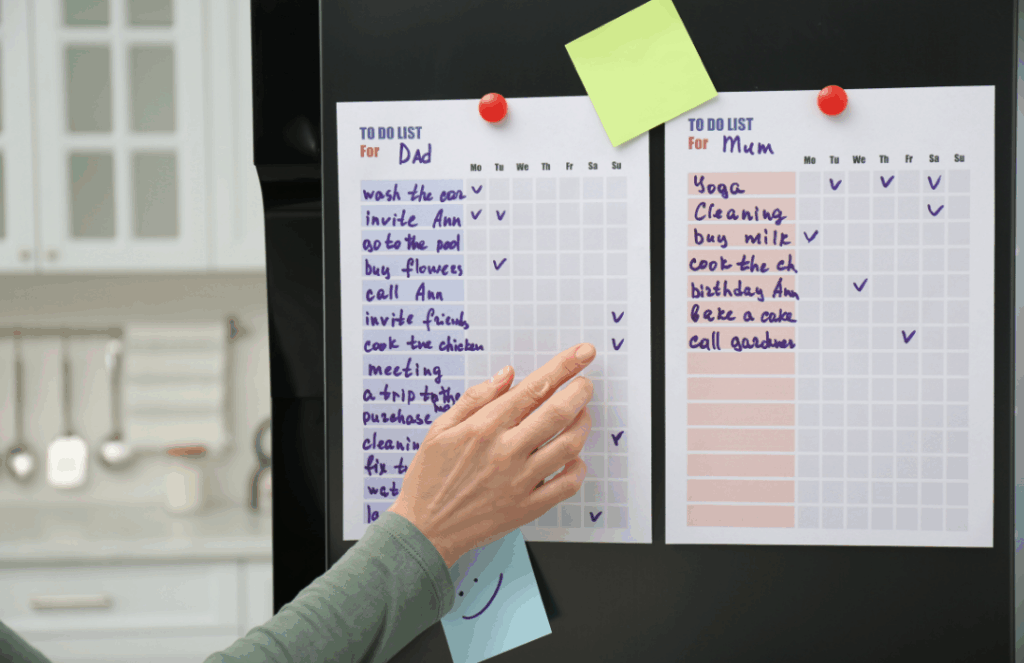Inside: Elevate your household experience with practical Home Management Tips that turn challenges into growth opportunities for the family.
Managing a household may seem daunting, but it can be a fulfilling and joyful experience with the right mindset and effective strategies. This guide presents actionable tips to elevate home management, from establishing a streamlined command center to effectively tracking the family budget. By implementing these approaches, you’ll foster collaboration, enhance safety, and cultivate a positive atmosphere, creating a home where everyone actively contributes to its success. Embrace the opportunity to transform your living space into a thriving environment for all.

Table of contents
- 1. Embrace a Positive Mental Approach
- 2. Establish an Organized Home Command Centre
- 3. Safety and Accessibility Checks
- 4. Use a Central Family Calendar
- 5. Declutter Regularly
- 6. Track and Stick to a Family Budget
- 7. Develop Strong Routines and Habits
- 8. Implement Regular Planning Sessions
- 9. Set Realistic Goals and Priorities
- 10. Meal Planning and Batch Cooking
- 11. Optimize Storage Solutions
- 12. Delegate Chores to Empower Family Members
- 13. Use Technology to Streamline Tasks
1. Embrace a Positive Mental Approach

A positive mindset can transform home management from mere survival to joyful thriving. View challenges as opportunities for growth and learning:
- See tasks like laundry as chances to improve routines or try eco-friendly products
- Use unexpected issues (like a burst pipe) to learn new skills and involve family in problem-solving
- Turn cooking mishaps into creative challenges using pantry staples
Practice daily gratitude by celebrating small victories, whether decluttering a space or finding a rhythm with family conversations. Look for natural inspiration, your child’s smile, or simple pleasures like fresh coffee.
Share this positive approach with your family. Encourage everyone to look for silver linings and treat home management as a shared adventure. With humour and commitment to staying upbeat, you’ll create an environment where joy, gratitude, and resilience thrive.
2. Establish an Organized Home Command Centre

Create a dedicated space in your home to bring order to daily chaos. This home command center acts as the nerve center of household operations, where schedules align and tasks find their home.
Choose a high-traffic area like the kitchen, entryway, or family room. Set up a desk, table, or wall-mounted shelf with enough space for essentials:
- Calendar: Display upcoming events clearly
- Baskets and trays: Organize mail, keys, and charging cables
- Bulletin boards or magnetic strips: Pin essential documents and artwork
- Notepads and pens: Encourage quick note-taking
- Whiteboards or chalkboards: List to-dos and inspirational messages
Your home command center promotes organization, communication, and harmony within your household. It ensures everyone stays informed and prepared, turning everyday challenges into a smoother weekly journey.
3. Safety and Accessibility Checks

Regular safety and accessibility checks are crucial for maintaining a secure and welcoming home. Conduct room-by-room inspections, looking for hazards like cracked sidewalks, wobbly stairs, or warped floorboards.
Assess accessibility in common areas to create an age-friendly environment. Consider installing grab bars in bathrooms or adding extra lighting in hallways. For multi-generational homes, explore options like ramps or stairlifts to improve mobility for older family members.
Remember pet safety. Ensure secure fencing and smooth access to outdoor spaces for your furry friends.
Establish a twice-yearly schedule for these checks, coinciding with other home maintenance tasks. If repairs exceed your skills, consult professionals to ensure everything meets safety standards.
By prioritizing safety and accessibility, you create a home where all family members can move freely and feel secure, fostering a comfortable environment for everyone.
4. Use a Central Family Calendar

A central family calendar is an essential tool for home management. It turns scheduling chaos into order and ensures no one misses important events or appointments.
Choose between a digital platform like Google Calendar or a physical wall calendar. Color-code each family member’s schedule for easy identification. For digital calendars, sync them across devices and set up notifications.
Share calendar management responsibilities by rotating the role of “calendar captain.” This person can:
- Send reminders
- Check for scheduling conflicts
- Occasionally, add surprise events to keep things interesting
A central family calendar encourages communication, fosters accountability, and teaches time management. It provides a unified view of family commitments, allowing for better planning and more time to enjoy spontaneous moments together.
5. Declutter Regularly

Regular decluttering refreshes your home and relieves stress. Make it a family activity, giving everyone a say in what stays and what goes. Start by identifying areas that need attention, like closets, playrooms, or basements.
Turn decluttering into an experience rather than a chore. Play upbeat music and assign roles:
- One family member sorts
- Another evaluates
- A third organizes items into keep, donate, or discard piles
Encourage family members to consider whether items bring joy or serve a purpose. If not, it’s time to let go. Organizing garage sales or donation runs can give decluttered items a new purpose.
Schedule regular decluttering sessions, perhaps quarterly, to maintain momentum. This practice fosters a mindset of simplicity and gratitude while creating a more inviting living space for everyone to enjoy.
6. Track and Stick to a Family Budget

Creating and maintaining a family budget is key to financial stability. Start by gathering the family to discuss income and expenses. List all sources of income, then categorize costs like groceries, utilities, and entertainment.
Utilize personal finance apps like Mint or YNAB to track spending in real-time, set goals, and receive reminders. These apps can convert complex budget information into easy-to-understand visualizations.
Regular budget check-ins, whether quick solo reviews or monthly family meetings, help you stay on track. Encourage everyone to contribute to the conversation, as family involvement can lead to better financial habits.
Ultimately, tracking and sticking to a family budget aligns your lifestyle with your family’s values and aspirations. It reduces financial stress and frees up resources for enjoyable activities, from spontaneous outings to planned family trips.
7. Develop Strong Routines and Habits

Developing intense routines for your home management tasks helps create structure and efficiency. Start with a morning routine that energizes you, like enjoying coffee while reviewing the day’s agenda. Establish a midday check-in to gauge progress and adjust as needed. In the evening, encourage a family “Ten-Minute Tidy-Up” to reset your home for the next day.
Make habits manageable, rewarding, and fun. Turn chores into mini-challenges, like finishing tasks before a song ends. With creativity, even mundane tasks can become more enjoyable.
These routines and habits form a framework that supports your household’s unique needs. They help tasks flow more easily and free up time for family activities. They bring peace and control to daily life, allowing you to approach your days with intention.
8. Implement Regular Planning Sessions

Planning sessions are opportunities to adjust and focus on what’s essential in home management. Establishing a daily or weekly routine can turn a hectic schedule into a more relaxed experience.
Choose a comfortable spot and make this time memorable. Gather your notes, calendars, and papers to create a plan for the days ahead.
Use this session to coordinate calendars across the family. Have a quick meeting to ensure everyone knows the week’s events. This helps manage household activities and allows discussion of preferences and expectations.
Consider using technology like Google Calendar to sync schedules, keeping everyone informed about visits or appointments.
Be flexible, as life brings surprises. Your plan is a guide, not a strict rule. Adjust timing or change less essential tasks without guilt—focus on progress, not perfection.
These planning sessions create clarity and purpose. With a clear focus and positive outlook, you’ll feel prepared for the week ahead, turning your home into a place of harmony.
9. Set Realistic Goals and Priorities

Setting realistic goals and priorities helps you stay productive without feeling overwhelmed. Begin by identifying essential tasks – your “non-negotiables” that keep your household running smoothly. List these core priorities first.
Add a few optional tasks – the “it would be nice if” items that enhance life but won’t cause problems if left undone.
Group tasks by urgency and importance. Focus on completing a few impactful tasks rather than starting many and finishing none. Use your energy wisely to maintain sanity.
Remember, achieving smaller, realistic goals creates momentum and provides small victories that boost morale.
Embrace flexibility, too. Life’s unpredictability means goals sometimes need adjusting. Allow room for unexpected events without losing balance.
Setting realistic goals and priorities is about creating a sustainable and enjoyable routine. It involves assessing what matters and approaching tasks with a sense of achievement rather than obligation. Once you let go of unrealistic expectations, your productivity increases and stress decreases.
10. Meal Planning and Batch Cooking

Meal planning and batch cooking are valuable tools in home management. They’re a strategic approach to achieving family mealtime harmony, reducing stress over last-minute dinner decisions, and minimizing food waste.
- Set aside time to outline your weekly meal schedule
- Check your pantry and fridge for available ingredients
- Brainstorm meals using these items
- Focus on simple, versatile recipes for batch cooking
- Consider hearty soups, stews, or large-batch chilli
- Repurpose leftovers creatively
- Invest in glass storage containers for easy reheating and fridge organization
Incorporating meal planning and batch cooking streamlines grocery shopping, saves time, and allows you to enjoy homemade meals during busy periods. With meals prepared in advance, you’re free to embrace spontaneous moments, adding joy and reducing stress in your daily life.
11. Optimize Storage Solutions

A key secret in home management is optimizing storage solutions. A clutter-free home creates a more peaceful and organized atmosphere. Think vertically and use multi-functional furniture to transform your space.
- Use the unused high space with tall bookshelves and floor-to-ceiling cabinets
- Install floating shelves above doorways or in hallways
- Try multi-functional furniture like coffee tables with hidden compartments
- Consider wall-mounted fold-out desks for efficient workspaces in small areas
- Use overhead storage racks in the garage or basement
- Organize smaller items with baskets, bins, and labelled containers
The goal is to make storage solutions work for you, creating a space that balances form and function. By optimizing storage, you’re designing a lifestyle that values organization and tranquillity.
12. Delegate Chores to Empower Family Members

Delegating chores improves your living space and fosters responsibility and teamwork. Assess each family member’s age and ability. Children can learn to pick up toys, while preteens might handle vacuuming or dishwashing. With the right motivation, teenagers could become BBQ or recycling experts.
Hold regular family meetings to discuss the chore roster and any challenges. This open communication cultivates a shared understanding that running a home is a group effort. It’s also a chance to celebrate small wins and solve issues.
Consider using an app like OurHome to organize and reward chores, turning routine tasks into a game with points and prizes.
Give family members freedom to complete tasks their way while ensuring they understand the importance of their responsibilities. You’ll lighten your load and prepare them for the real world. Even busy days can feel less chaotic and more harmonious in a household where everyone contributes.
13. Use Technology to Streamline Tasks

Using technology can significantly ease home management. Start with simple apps for daily tasks like Evernote or Trello to organize lists and schedules. Find tools that fit smoothly into your routine without creating digital clutter.
Sync a shared family calendar to prevent overlaps and missed appointments. Google Calendar offers excellent features for family scheduling, including sharing with multiple people.
Meal planning apps like Yummly simplify deciding what’s for dinner by generating ideas based on available ingredients and helping manage shopping lists.
Smart home devices streamline everyday chores. Use virtual assistants to set reminders, order groceries, or control lighting and temperature settings.
Consider online financial tools like Mint or YNAB to manage monthly budgets, track expenses, and suggest savings strategies.
The goal is to simplify your workload. Let technology do the heavy lifting so you can focus on what matters, like spending quality time with family and relaxing.
In conclusion, effective home management transcends organization; it cultivates a nurturing family environment. You foster harmony and strengthen bonds by embracing a positive mindset, creating a command center, ensuring safety, using a central calendar, and decluttering regularly. Embrace these strategies to transform your home into a thriving space filled with meaningful moments.

Leave a Reply